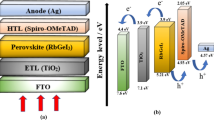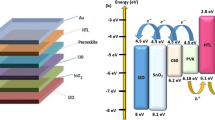Abstract
We report a model of CZTS/ZnS/ZnO nanorod device designed using optical coefficients of each thin film layers obtained from the experimental results. The \(J-V\) characteristic was compared with available experimental result in order to validate our model. In this model, we have examined the effect of thickness of each material layer, CZTS minority carrier lifetime, CZTS acceptor concentration, shallow and deep states formed during the fabrication process on the photovoltaic device parameters. The thickness of the CZTS absorber, buffer and window layer are optimized using optoelectronic simulations and the optimum thicknesses are found to be 2.5–3.0 µm, 30 nm and 500 nm respectively. Also, we analyzed the effect of shallow states and deep states in CZTS and ZnO layer on the photovoltaic parameters of the solar cell. After optimization of the above mentioned parameters, it is observed that the efficiency of the solar cell is improved from 3.69 to 7.65%.










Similar content being viewed by others
Change history
23 February 2018
The original version of this article was published with the following errors. This has been corrected with this erratum.
References
J. Ramanujam, U.P. Singh, Copper indium gallium selenide based solar cells: a review. Energy Environ. Sci. 10(6), 1306–1319 (2017)
J.M. Burst et al., CdTe solar cells with open-circuit voltage breaking the 1 V barrier. Nat. Energy 1, 16015 (2016)
M.A. Green et al., Solar cell efficiency tables (version 49). Prog. Photovolt. Res. Appl. 25(1), 3–13 (2016)
T.P. Dhakal, C.-Y. Peng, R.R. Tobias, R. Dasharathy, C.R. Westgate, Characterization of a CZTS thin film solar cell grown by sputtering method. Sol. Energy 100, 23–30 (2014)
D. Tang et al., An alternative route towards low-cost Cu2ZnSnS4 thin film solar cells. Surf. Coat. Technol. 232, 53–59 (2013)
Y.S. Lee et al., Cu2ZnSnSe4 thin-film solar cells by thermal coevaporation with 11.6% efficiency and improved minority carrier diffusion length. Adv. Energy Mater. 5(7), 1401372 (2015)
D. Aldakov, A. Lefrançois, P. Reiss, Ternary and quaternary metal chalcogenide nanocrystals: synthesis, properties and applications. J. Mater. Chem. C 1(24), 3756–3776 (2013)
W. Wang et al., Device characteristics of CZTSSe thin-film solar cells with 12.6% efficiency. Adv. Energy Mater. 4(7), 1301465 (2014)
B. Shin et al., Thin film solar cell with 8.4% power conversion efficiency using an earth-abundant Cu2ZnSnS4 absorber. Prog. Photovolt. Res. Appl. 21(1), 72–76 (2013)
H. Movla, Optimization of the CIGS based thin film solar cells: numerical simulation and analysis. Optik 125(1), 67–70 (2014)
A.D. Adewoyin, M.A. Olopade, M.A. Chendo, Enhancement of the conversion efficiency of Cu2ZnSnS4 thin film solar cell through the optimization of some device parameters. Optik 133, 122–131 (2017)
I. Bouchama, S.A. Saoucha, Effect of wide band-gap TCO properties on the bifacial CZTS thin-films solar cells performances. Optik 144, 370–377 (2017)
H. ElAnzeery et al., Refractive index extraction and thickness optimization of Cu2ZnSnSe4 thin film solar cells. Phys. Status Solidi A 212(9), 1984–1990 (2015)
S.R. Meher, L. Balakrishnan, Z.C. Alex, Analysis of Cu2ZnSnS4/CdS based photovoltaic cell: a numerical simulation approach. Superlattices Microstruct. 100, 703–722 (2016)
M. Courel, J.A. Andrade-Arvizu, O. Vigil-Galan, Towards a CdS/Cu2ZnSnS4 solar cell efficiency improvement: a theoretical approach. Appl. Phys. Lett. 105(23), 1–4 (2014)
M. Courel, J.A. Andrade-Arvizu, O. Vigil-Galán, Loss mechanisms influence on Cu2ZnSnS4/CdS-based thin film solar cell performance. Solid State Electron. 111, 243–250 (2015)
M. Courel, J.A. Andrade-Arvizu, O. Vigil-Galán, The role of buffer/kesterite interface recombination and minority carrier lifetime on kesterite thin film solar cells. Mater. Res. Express 3(9), 1–14 (2016)
O.A.M. Abdelraouf, N.K. Allam, Nanostructuring for enhanced absorption and carrier collection in CZTS-based solar cells: coupled optical and electrical modeling. Opt. Mater. 54, 84–88 (2016)
A. Ghosh, R. Thangavel, A. Gupta, Solution-processed Cd free kesterite Cu2ZnSnS4 thin film solar cells with vertically aligned ZnO nanorod arrays. J. Alloys Compd. 694, 394–400 (2017)
Silvaco Inc., Atlas User’s Manual Device Simulation Software (Silvaco Inc., Santa Clara, 2010)
A. Layek, B. Manna, A. Chowdhury, Carrier recombination dynamics through defect states of ZnO nanocrystals: From nanoparticles to nanorods. Chem. Phys. Lett. 539–540, 133–138 (2012)
D. Lee, K. Yong, Superstrate CuInS2 photovoltaics with enhanced performance using a CdS/ZnO nanorod array. ACS Appl. Mater. Interfaces. 4(12), 6758–6765 (2012)
D. Lee, K. Yong, Solution-processed Cu2ZnSnS4 superstrate solar cell using vertically aligned ZnO nanorods. Nanotechnology 25, 065401 (2014)
U. Saha, M.K. Alam, Proposition and computational analysis of a kesterite/kesterite tandem solar cell with enhanced efficiency. RSC Adv. 7, 4806–4814 (2017)
M. DjinkwiWanda, S. Ouédraogo, F. Tchoffo, F. Zougmoré, J.M.B. Ndjaka, Numerical investigations and analysis of Cu2ZnSnS4 based solar cells by SCAPS-1D. Int. J. Photoenergy 2016, 2152018 (2016)
F.Z. Boutebakh, M. Lamri Zeggar, N. Attaf, M.S. Aida, Electrical properties and back contact study of CZTS/ZnS heterojunction. Optik (2017). https://doi.org/10.1016/j.ijleo.2017.06.080
C.J. Hages, N.J. Carter, R. Agrawal, T. Unold, Generalized current-voltage analysis and efficiency limitations in non-ideal solar cells: case of Cu2ZnSn(SxSe1-x)4 and Cu2Zn(SnyGe1-y)(SxSe1-x)4. J. Appl. Phys. 115(234504), 1–14 (2014)
S. Mahajana et al., Enhancement in the efficiency of crystalline Cu2ZnSnS4 thin film solar cell by using various buffer layers. Superlattices Microstruct. 109, 240–248 (2017)
M. Kumar, A. Dubey, N. Adhikari, S. Venkatesan, Q. Qiao, Strategic review of secondary phases, defects and defect-complexes in kesterite CZTS-Se solar cells. Energy Environ. Sci. 8(11), 3134–3159 (2015)
S. Chen, X.G. Gong, A. Walsh, S.-H. Wei, Defect physics of the kesterite thin-film solar cell absorber Cu2ZnSnS4. Appl. Phys. Lett. 96(2), 021902 (2010)
S.A. Sopra, Software for the Design and Manufacture of Optical Thin Film Coatings. http://www.sspectra.com
B.G. Mendis et al., The role of secondary phase precipitation on grain boundary electrical activity in Cu2ZnSnS4 (CZTS) photovoltaic absorber layer material. J. Appl. Phys. 112(124508), 1–11 (2012)
A. Nagoya, R. Asahi, G. Kresse, First-principles study of Cu2ZnSnS4 and the related band offsets for photovoltaic applications. J. Phys. 23, 404203 (2011)
H. Arbouz, A. Aissat, J.P. Vilcot, Simulation and optimization of CdS-n/Cu2ZnSnS4 structure for solar cell applications structure for solar cell applications. Int. J. Hydrog. Energy 42(13), 8827–8832 (2017)
M. Courel, O. Vigil-Galán, Advanced Ceramic and Metallic Coating and Thin Film Materials for Energy and Environmental Applications (Springer, Cham, 2018)
A. Walsh, S. Chen, X.G. Gong, S.H. Wei, Crystal structure and defect reactions in the kesterite solar cell absorber Cu2ZnSnS4 (CZTS): theoretical insights. AIP Conf. Proc. 1399, 63–64 (2011)
Author information
Authors and Affiliations
Corresponding author
Rights and permissions
About this article
Cite this article
Vallisree, S., Thangavel, R. & Lenka, T.R. Theoretical investigations on enhancement of photovoltaic efficiency of nanostructured CZTS/ZnS/ZnO based solar cell device. J Mater Sci: Mater Electron 29, 7262–7272 (2018). https://doi.org/10.1007/s10854-018-8715-y
Received:
Accepted:
Published:
Issue Date:
DOI: https://doi.org/10.1007/s10854-018-8715-y




